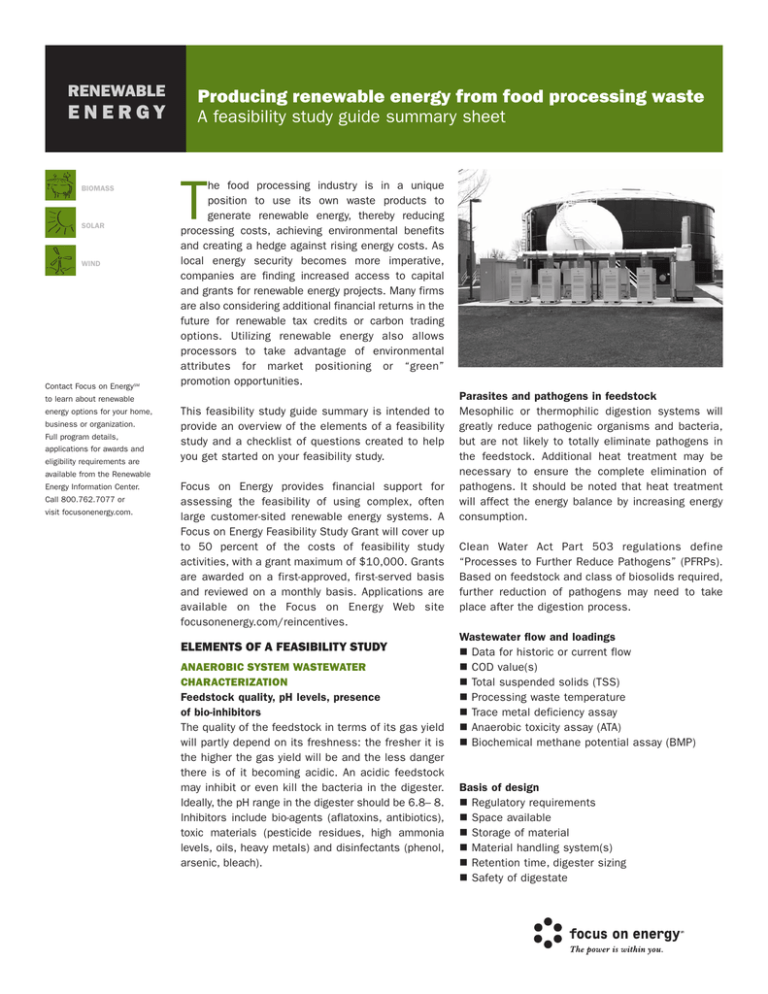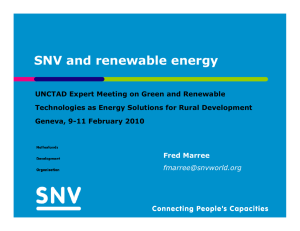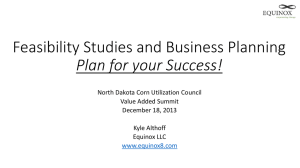Producing Renewable Energy from Food Processing Waste
advertisement

RENEWABLE ENERGY BIOMASS SOLAR WIND Contact Focus on EnergySM Producing renewable energy from food processing waste A feasibility study guide summary sheet he food processing industry is in a unique position to use its own waste products to generate renewable energy, thereby reducing processing costs, achieving environmental benefits and creating a hedge against rising energy costs. As local energy security becomes more imperative, companies are finding increased access to capital and grants for renewable energy projects. Many firms are also considering additional financial returns in the future for renewable tax credits or carbon trading options. Utilizing renewable energy also allows processors to take advantage of environmental attributes for market positioning or “green” promotion opportunities. T to learn about renewable energy options for your home, business or organization. Full program details, applications for awards and eligibility requirements are This feasibility study guide summary is intended to provide an overview of the elements of a feasibility study and a checklist of questions created to help you get started on your feasibility study. available from the Renewable Energy Information Center. Call 800.762.7077 or visit focusonenergy.com. Focus on Energy provides financial support for assessing the feasibility of using complex, often large customer-sited renewable energy systems. A Focus on Energy Feasibility Study Grant will cover up to 50 percent of the costs of feasibility study activities, with a grant maximum of $10,000. Grants are awarded on a first-approved, first-served basis and reviewed on a monthly basis. Applications are available on the Focus on Energy Web site focusonenergy.com/reincentives. ELEMENTS OF A FEASIBILITY STUDY ANAEROBIC SYSTEM WASTEWATER CHARACTERIZATION Feedstock quality, pH levels, presence of bio-inhibitors The quality of the feedstock in terms of its gas yield will partly depend on its freshness: the fresher it is the higher the gas yield will be and the less danger there is of it becoming acidic. An acidic feedstock may inhibit or even kill the bacteria in the digester. Ideally, the pH range in the digester should be 6.8– 8. Inhibitors include bio-agents (aflatoxins, antibiotics), toxic materials (pesticide residues, high ammonia levels, oils, heavy metals) and disinfectants (phenol, arsenic, bleach). Parasites and pathogens in feedstock Mesophilic or thermophilic digestion systems will greatly reduce pathogenic organisms and bacteria, but are not likely to totally eliminate pathogens in the feedstock. Additional heat treatment may be necessary to ensure the complete elimination of pathogens. It should be noted that heat treatment will affect the energy balance by increasing energy consumption. Clean Water Act Part 503 regulations define “Processes to Further Reduce Pathogens” (PFRPs). Based on feedstock and class of biosolids required, further reduction of pathogens may need to take place after the digestion process. Wastewater flow and loadings Data for historic or current flow COD value(s) Total suspended solids (TSS) Processing waste temperature Trace metal deficiency assay Anaerobic toxicity assay (ATA) Biochemical methane potential assay (BMP) Basis of design Regulatory requirements Space available Storage of material Material handling system(s) Retention time, digester sizing Safety of digestate Ease of operation considerations Start-up and shut-down processes Transportation, to treatment facility or off-site after treatment Plans for future expansion Pre-treatment and design accommodations Screening for foreign matter Adding water, or removing water Conditioning the waste (grinding, shredding) Stirring the feedstocks (equalizing batches) Waste stream from cleaning and clean-in-place operations Continuous feedstock or batch process waste Effects due to low loading rates, chemical precipitation, struvite formation, foaming Biogas clean-up or post-treatment Drying gas Removal of siloxanes, sulfur, magnesium or other contaminants CO2 removal Gas compression Include Mass/Flow Balance and Process Flow Diagram EVALUATION OF ANAEROBIC SYSTEM PERFORMANCE Biogas analysis, possible bench top testing Predicted biogas production Any benefits of bio-additives (enzymes or microbial mixtures) or micronutrients Batch or continuous process analysis Biogas storage analysis Thermal performance and predicted heat generation, adequacy of heat to run process Alkalinity requirements Startup time factor CHECKLIST QUESTIONS: GETTING STARTED WITH A FEASIBILITY STUDY In addition to costs and anticipated overall performance, a feasibility study should offer technology and process choices. It should also address some of the following questions: Were samples used for feasibility representative of the waste stream and probable deviations? Will the system meet regulatory requirements? Is the system flexible enough to meet changes in process waste and different levels of plant operation? Will any toxic materials be able to be biodegraded in the process? Is it difficult or costly to remove or accommodate bio-inhibitors in the waste? Will the base process biomass be retained in the system? How will the reactor vessel be maintained, can material be removed without shutting down the whole system? How long is start-up and what is required for shut-down? What are possible process upsets or shocks, can they be avoided or mitigated? How resistant will the system be to upsets or shocking? Does the engine-generator match the average gas output of the system? Is a back-up generator required? Is on-site testing available for periodic process evaluation and monitoring? Will the system accommodate new products and waste streams? Does the system seem reasonable and workable in construction, operation, ongoing monitoring or future maintenance? Due to the complexity of the feedstock or processing, is there a need for bench-scale testing? EVALUATION OF ELECTRICAL SYSTEM Usable biogas production Predicted electrical power generation Parasitic loads (from equipment and instruments required to operate any cogeneration system) System backup requirements Utility interface requirements COST ANALYSIS FOR RECOMMENDED ALTERNATIVES Capital cost O&M costs Training costs Payback This summary is intended to provide an overview of considerations that are of foremost importance in determining performance and design for producing renewable energy from food processing wastes. Focus on Energy works with eligible Wisconsin residents and businesses to install cost effective energy efficiency and renewable energy projects. Focus information, resources and financial incentives help to implement projects that otherwise would not be completed, or to complete projects sooner than scheduled. Its efforts help Wisconsin residents and businesses manage rising energy costs, promote in-state economic development, protect our environment and control the state’s growing demand for electricity and natural gas. For more information, call 800.762.7077 or visit focusonenergy.com. © 2008 Wisconsin Focus on Energy REN-2071-1208





